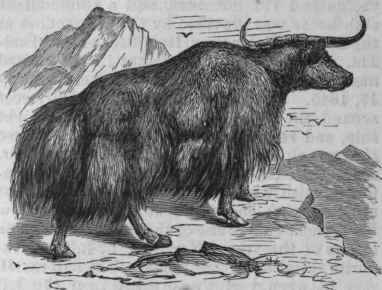Yak (Poephagus Grunniens Gray)
Description
This section is from "The American Cyclopaedia", by George Ripley And Charles A. Dana. Also available from Amazon: The New American Cyclopśdia. 16 volumes complete..
Yak (Poephagus Grunniens Gray)
Yak (PoŽPhagus Grunniens Gray), an animal of the ox tribe, inhabiting the mountains of Thibet and central Asia. The wild yak is larger than domestic cattle, generally black, and characterized by a thick fringe of long hair hanging from the lower part of the body nearly to the ground; the general covering is long, thick, and soft, the head short, horns round and smooth, ears, nose, and nostrils small, forehead apparently prominent on account of the curling hair, eyes large and full, neck short, shoulders high and arched, rump low, and legs very short; the hair of the tail is long and fine as in the horse; they seem heavier than they really are, and have rather a downcast, sullen, and suspicious look; they are found only near the line of perpetual snow. The domesticated yak is nearly 4 ft. high at the shoulders, and 7 ft. long from nose to tail; they vary in size and color, probably from intermixture with common cattle, but have the fringe on the lower parts; they make a grunting noise, whence the specific name. They are strong and sure-footed, and are used in agriculture and as beasts of burden; tents and ropes are made of the hair, and caps and jackets of the skins; the milk is rich and the butter excellent; the latter is kept in skins and bladders for a year, and forms an important article of merchandise.
Their tails are esteemed in India as brushes for driving off flies and other insects from men, horses, and elephants; they are often set in costly handles, and are called chowries; the Chinese dye them red, and wear them in their hats. Those with white tails are most esteemed, and the horns are sometimes as white as ivory.

Yak (PoŽphagus grunniens).
Continue to:


